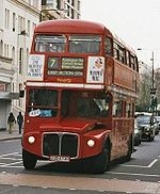
Buses in London
Encyclopedia
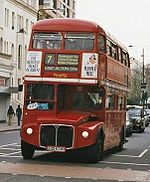
London
London is the capital city of :England and the :United Kingdom, the largest metropolitan area in the United Kingdom, and the largest urban zone in the European Union by most measures. Located on the River Thames, London has been a major settlement for two millennia, its history going back to its...
's principal icons, the archetypal red rear-entrance double-deck Routemaster
Routemaster
The AEC Routemaster is a model of double-decker bus that was built by Associated Equipment Company in 1954 and produced until 1968. Primarily front-engined, rear open-platform buses, a small number of variants were produced with doors and/or front entrances...
being recognised worldwide. Although the Routemaster has now been largely phased out of service, with only two heritage routes still using the vehicles, the majority of buses in London are still red and therefore the red bus remains an iconic symbol of the city.
History

Organisation
Buses have been used on the streets of London since 1829, when George ShillibeerGeorge Shillibeer
George Shillibeer was an English coachbuilder.Shillibeer was born in St Marylebone, London the son of Abraham and Elizabeth Shillibeer. Christened in St Marys Church, Marylebone on 22 October 1797, Shillibeer worked for the coach company Hatchetts in Long Acre, the coach-building district of the...
started operating his horse drawn omnibus service from Paddington
Paddington
Paddington is a district within the City of Westminster, in central London, England. Formerly a metropolitan borough, it was integrated with Westminster and Greater London in 1965...
to the city
City of London
The City of London is a small area within Greater London, England. It is the historic core of London around which the modern conurbation grew and has held city status since time immemorial. The City’s boundaries have remained almost unchanged since the Middle Ages, and it is now only a tiny part of...
. In 1850 Thomas Tilling
Thomas Tilling
Thomas Tilling Ltd, later known with its subsidiary companies as the Tilling Group, was one of the two huge groups which controlled almost all the major bus operators in the United Kingdom between the wars and until nationalisation in 1948....
started horse bus services, and in 1855 the London General Omnibus Company
London General Omnibus Company
The London General Omnibus Company or LGOC, was the principal bus operator in London between 1855 and 1933. It was also, for a short period between 1909 and 1912, a motor bus manufacturer.- Overview :...
or LGOC was founded to amalgamate and regulate the horse-drawn omnibus services then operating in London.
LGOC began using motor omnibuses in 1902, and manufactured them itself from 1909. In 1904 Thomas Tilling started its first motor bus service. The last LGOC horse-drawn bus ran on 25 October 1911, although independent operators used them until 1914.
In 1909 Thomas Tilling and LGOC entered into an agreement to pool their resources. The agreement restricted the expansion of Thomas Tilling in London, and allowed the LGOC to lead an amalgamation of most of London's bus services. However, also in 1909 Thomas Clarkson started the National Steam Car Company to run steam bus
Steam bus
A steam bus is a bus powered by a steam engine. Early steam-powered vehicles designed for carrying passengers were more usually known as steam carriages, although this term was sometimes used to describe other early experimental vehicles too.-History:...
es in London in competition with the LGOC. In 1919 the National company reached agreement with the LGOC to withdraw from bus operation in London, and steam bus services ceased later that year.
In 1912 the Underground Group, which at that time owned most of the London Underground
London Underground
The London Underground is a rapid transit system serving a large part of Greater London and some parts of Buckinghamshire, Hertfordshire and Essex in England...
, bought the LGOC. In 1933 the LGOC, along with the rest of the Underground Group, became part of the new London Passenger Transport Board
London Passenger Transport Board
The London Passenger Transport Board was the organisation responsible for public transport in London, UK, and its environs from 1933 to 1948...
. The name London General was replaced by London Transport, which became synonymous with the red London bus.
The LPTB assumed responsibility for all bus services in the London Passenger Transport Area, an area with a radius of about 30 miles of central London. This included the London General country buses (later to be London Transport's green buses), Green Line Coaches
Green Line Coaches
Green Line is a commuter coach brand in the Home Counties of England. It is owned by the Arriva group.Green Line has its origin in the network of coach services established by the London General Omnibus Company in the 1920s and 1930s...
and the services of several Tilling Group and independent companies.
London buses continued under the London Transport name under the management of the LPTB (1933 to 1947), the London Transport Executive
London Transport Executive
The London Transport Executive was the organisation responsible for public transport in the Greater London area, UK, between 1948-1962. In common with all London transport authorities from 1933 to 2000, the public name and operational brand of the organisation was London Transport.-Creation:On 1...
(1948 to 1962), the London Transport Board
London Transport Board
The London Transport Board was the organisation responsible for public transport in London, UK, and its environs from 1963-1969. In common with all London transport authorities from 1933 to 2000, the public name and operational brand of the organisation was London Transport.-History:The...
(1963 to 1969), the Greater London Council
Greater London Council
The Greater London Council was the top-tier local government administrative body for Greater London from 1965 to 1986. It replaced the earlier London County Council which had covered a much smaller area...
(1970 to 1984) and London Regional Transport
London Regional Transport
London Regional Transport was the organisation responsible for the public transport network in Greater London, UK from 1984-2000. In common with all London transport authorities from 1933 to 2000, the public name and operational brand of the organisation was London Transport.The organisation was...
(1984 to 2000). However in 1969 legislation was passed to transfer the green country services, outside the area of the Greater London Council, to the recently-formed National Bus Company
National Bus Company UK
The National Bus Company was, from 1969 to 1988, a nationalised bus company in England and Wales. NBC did not run buses itself, but was the owner of a number of regional subsidiary bus operating companies.-History:-Background:...
. Trading under the name London Country the green buses and Green Line Coaches became the responsibility of a new NBC subsidiary, London Country Bus Services
London Country Bus Services
London Country Bus Services was a bus company that operated in South East England from 1969 until split up and sold in 1986 under Margaret Thatcher's government's bus deregulation scheme.-Creation:...
, on 1 January 1970.
In the 1980s the government of Margaret Thatcher
Margaret Thatcher
Margaret Hilda Thatcher, Baroness Thatcher, was Prime Minister of the United Kingdom from 1979 to 1990...
decided to privatise the bus operating industry in the United Kingdom
United Kingdom
The United Kingdom of Great Britain and Northern IrelandIn the United Kingdom and Dependencies, other languages have been officially recognised as legitimate autochthonous languages under the European Charter for Regional or Minority Languages...
, which at that time was dominated by London Transport in London, large municipally-owned operators in other major cities and the government-owned National Bus Company and Scottish Bus Group
Scottish Bus Group
The Scottish Bus Group was a state-owned Scottish holding company that included a number of bus operators covering the whole of Scotland. The group was formed in 1961 as Scottish Omnibuses Group Ltd, to take control of the British Transport Commission's bus operating subsidiaries in Scotland...
elsewhere. For largely political reasons the model followed in London was completely different from the rest of the country. In London a part of London Transport called London Buses
London Buses
London Buses is the subsidiary of Transport for London that manages bus services within Greater London, UK. Buses are required to carry similar red colour schemes and conform to the same fare scheme...
was set up, with the remit to contract out the operation of services but to determine service levels and fares within the public sector.
This regime is still in place, although the ownership of London Buses
London Buses
London Buses is the subsidiary of Transport for London that manages bus services within Greater London, UK. Buses are required to carry similar red colour schemes and conform to the same fare scheme...
moved from the central (UK) government-controlled London Regional Transport to the Mayor of London's
Mayor of London
The Mayor of London is an elected politician who, along with the London Assembly of 25 members, is accountable for the strategic government of Greater London. Conservative Boris Johnson has held the position since 4 May 2008...
transport organisation, Transport for London
Transport for London
Transport for London is the local government body responsible for most aspects of the transport system in Greater London in England. Its role is to implement the transport strategy and to manage transport services across London...
, in 2000, as part of the formation of the new Greater London Authority
Greater London Authority
The Greater London Authority is the top-tier administrative body for Greater London, England. It consists of a directly elected executive Mayor of London, currently Boris Johnson, and an elected 25-member London Assembly with scrutiny powers...
.
Vehicles
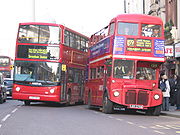
London General Omnibus Company
The London General Omnibus Company or LGOC, was the principal bus operator in London between 1855 and 1933. It was also, for a short period between 1909 and 1912, a motor bus manufacturer.- Overview :...
(LGOC) in the 1900s until the 1960s London went its own way, designing its own vehicles specially for London use rather than using the bus manufacturers' standard products used elsewhere. The Associated Equipment Company (AEC) was created as a subsidiary of the LGOC in 1912 to build buses and other equipment for its parent company, and continued in the ownership of LGOC and its successors until 1962. Many of London's local service buses over this period were built by AEC, although other manufacturers also built buses to London designs, or modified their own designs for use in London.
The last bus specifically designed for London was the AEC Routemaster
Routemaster
The AEC Routemaster is a model of double-decker bus that was built by Associated Equipment Company in 1954 and produced until 1968. Primarily front-engined, rear open-platform buses, a small number of variants were produced with doors and/or front entrances...
, built between 1956 and 1968. Since then, buses built for London's local services have all been variants of models built for general use elsewhere, although bus manufacturers would routinely offer a 'London specification' to meet specific London requirements. Some manufacturers even went so far as to build new models with London in mind, such as the DMS class Daimler Fleetline
Daimler Fleetline
The Daimler Fleetline is a rear-engined double-decker bus chassis built between 1960 and 1973 in Coventry, Warwickshire, England, and from 1973 until 1980 in Farington, Lancashire, England. However, the last complete vehicle did not enter service until 1983...
, and the T class Leyland Titan (B15)
Leyland Titan (B15)
The Leyland Titan was a model of double-decker bus produced by the Leyland Truck & Bus division of British Leyland from 1977 until 1984, almost exclusively for London Transport.-Development:...
.
London did see the introduction of several of the newly emerging minibus
Minibus
A minibus or minicoach is a passenger carrying motor vehicle that is designed to carry more people than a multi-purpose vehicle or minivan, but fewer people than a full-size bus. In the United Kingdom, the word "minibus" is used to describe any full-sized passenger carrying van. Minibuses have a...
and midibus
Midibus
A midibus is a classification of single-decker minibuses which generally are larger than a traditional minibus but smaller than a full-size single decker and can be anywhere between and long...
models in the 1980s and 1990s, in a bid to up the frequency on routes, although the use of these buses dropped off to the level of niche operation on routes not suitable for full size buses.
With the move to tendered contracts for TfL routes, the 'London specification' was further enforced as being part of tender proposals, invariably specifying new buses. The major difference for London is the usage of dual doors on central routes.
London was one of the earliest major users of low-floor bus
Low-floor bus
A low-floor bus is a bus that has no steps between one or more entrances and part or all of the passenger cabin. Being low floor improves the accessibility of the bus for the public, particularly the elderly or infirm, or those with push chairs, and increasingly, those in wheelchairs.In the modern...
es. From 2000, the mainstay of fleet, double-decker bus
Double-decker bus
A double-decker bus is a bus that has two storeys or 'decks'. Global usage of this type of bus is more common in outer touring than in its intra-urban transportion role. Double-decker buses are also commonly found in certain parts of Europe, Asia, and former British colonies and protectorates...
es, were augmented with a fleet of articulated bus
Articulated bus
An articulated bus is an articulated vehicle used in public transportation. It is usually a single-deck design, and comprises two rigid sections linked by a pivoting joint...
es, rising to a peak fleet size of 393 Mercedes-Benz O530 Citaro
Mercedes-Benz O530 Citaro
The Mercedes-Benz Citaro is the current Mercedes-Benz/EvoBus mainstream single-decker bus intended for public transport, introduced in 1997 and replaced the Mercedes-Benz O405/O405N series...
s. A small fleet of hybrid buses
Hybrid buses in London
Hybrid buses are operated on a small number of bus services in London. The first were introduced in March 2006, and 56 are now used. Transport for London has stated that it intends to make all new buses delivered for use in London hybrids from 2012....
is also operated.
New Routemaster / Bendy bus withdrawal

London mayoral election, 2008
The London mayoral election, 2008 for the office of Mayor of London was held on 1 May 2008 and was won by Conservative Party candidate Boris Johnson....
, prospective mayor Boris Johnson
Boris Johnson
Alexander Boris de Pfeffel Johnson is a British journalist and Conservative Party politician, who has been the elected Mayor of London since 2008...
made several commitments to change the London Buses vehicle policy, namely to introduce a new Routemaster, and remove the bendy buses
Articulated bus
An articulated bus is an articulated vehicle used in public transportation. It is usually a single-deck design, and comprises two rigid sections linked by a pivoting joint...
.
Following his election to office on 4 May 2008, on 4 July 2008 Transport for London
Transport for London
Transport for London is the local government body responsible for most aspects of the transport system in Greater London in England. Its role is to implement the transport strategy and to manage transport services across London...
announced the New Bus for London Competition, in which conceptual and detailed design proposals would be sought for a new hybrid
Hybrid vehicle
A hybrid vehicle is a vehicle that uses two or more distinct power sources to move the vehicle. The term most commonly refers to hybrid electric vehicles , which combine an internal combustion engine and one or more electric motors.-Power:...
Routemaster, with development of a design that could be put into production hoped for completion by 2012 (the expected date of the next mayoral election).
In August 2008, the London Transport Commissioner
Commissioner of Transport for London
The Commissioner of Transport for London has management responsibility for Transport for London and hence for the transport system throughout the City of London and Greater London in the United Kingdom. TfL is controlled by a board whose members are appointed by the Mayor of London, who also...
Peter Hendy
Peter Hendy
Peter Hendy, CBE is the current Commissioner of Transport for London.-Early career:He started his career in the public transport industry in 1975 as a London Transport graduate trainee...
announced that the withdrawal of the bendy buses would take place, starting in 2009. So as to reduce additional costs to TfL, the buses would be withdrawn as their 5 year operating contracts came up for renewal, with the replacement types being decided by operators. Options for replacement would not preclude such measures as tri-axle bus
Multi-axle bus
A multi-axle bus is a bus or coach that has more than the conventional two axles, usually three , or more rarely, four...
es. However, research has indicated that removing articulated vehicles may not be without cost; London Travel Watch undertook a study in September 2008 which found that to replace articulated vehicles on three bus routes, and maintain overall route capacity, would cost an additional £12.6m per annum, due to the additional vehicles necessitated.
On 7 December 2008 Boris Johnson appeared as the "Star In a Reasonably Priced Car" on BBC2's Top Gear
Top Gear (current format)
Top Gear is a British television series about motor vehicles, primarily cars. It began in 1977 as a conventional motoring magazine show. Over time, and especially since a relaunch in 2002, it has developed a quirky, humorous style...
in which Jeremy Clarkson questioned him about his plans to withdraw Bendy Buses, which, as he pointed out, Johnson had announced he planned to do many months prior to this and asked when he actually planned to put this into practice, to which Johnson replied they'd be off the road "by around 2010". A couple of episodes earlier fellow Presenter Richard Hammond
Richard Hammond
Richard Mark Hammond is an English broadcaster, writer, and journalist most noted for co-hosting car programme Top Gear with Jeremy Clarkson and James May, as well as presenting Brainiac: Science Abuse on Sky 1.-Early life:...
had overseen a Drag Race between different types of Buses used in London to see which was the best. The Single-Decker Bus had won, but only because the Double-Decker fell on its side on the last corner.
The first buses to be withdrawn would be the Red Arrow
Red Arrow (bus)
Red Arrow was branding given to two current and several former London bus limited stop routes used as high frequency commuter services in central London...
fleet on route 507
London Buses route 507
London Buses route 507 is a Transport for London contracted bus route in London, United Kingdom. The service is currently contracted to Go-Ahead London.-History:...
and route 521
London Buses route 521
London Buses route 521 is a Transport for London contracted bus route in London, United Kingdom. The service is currently contracted to Go-Ahead London.-History:Service 521 is one of two Red Arrow routes, the other being route 507, that survived into 2009....
(although the latter route requires single deckers due to its running through the Strand Underpass), in May 2009, followed by the route 38
London Buses route 38
London Buses route 38 is a Transport for London contracted bus route in London, United Kingdom. The service is currently contracted to Arriva London....
in July. Having received new buses in February, the last route to use articulated buses would be route 453
London Buses route 453
London Buses route 453 is a Transport for London contracted bus route in London, England. The service is currently contracted to Go-Ahead London.-History:...
, in 2013 (2015 if a two year contract extension is taken up). This has now been changed to 24th September 2011 for the start of double deck operation.
In May 2010 London Mayor Boris Johnston unveiled the design of the New Bus for London, the proposed replacement for the Routemaster as an iconic standard bus for exclusive use in London. The buses, designed by Heatherwick Studio and built by Wrightbus will feature two staircases, three doors and an open platform allowing passengers to hop on and off, and are due to start running in 2012.
Local buses
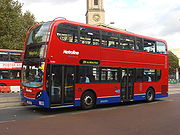

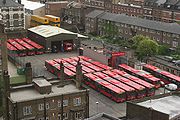
Most local buses within London form a network managed by London Buses
London Buses
London Buses is the subsidiary of Transport for London that manages bus services within Greater London, UK. Buses are required to carry similar red colour schemes and conform to the same fare scheme...
, an arm of Transport for London
Transport for London
Transport for London is the local government body responsible for most aspects of the transport system in Greater London in England. Its role is to implement the transport strategy and to manage transport services across London...
, although most services are operated by private sector
Private sector
In economics, the private sector is that part of the economy, sometimes referred to as the citizen sector, which is run by private individuals or groups, usually as a means of enterprise for profit, and is not controlled by the state...
companies under contract to London Buses. With the introduction of the London congestion charge
London congestion charge
The London congestion charge is a fee charged for some categories of motor vehicle to travel at certain times within the Congestion Charge Zone , a traffic area in London. The charge aims to reduce congestion, and raise investment funds for London's transport system...
in central London and because at peak times the Underground
London Underground
The London Underground is a rapid transit system serving a large part of Greater London and some parts of Buckinghamshire, Hertfordshire and Essex in England...
is operating at maximum capacity, many bus service improvements have been undertaken, and central bus services are currently enjoying something of a resurgence.
Although the rear-entrance double-deck Routemaster
Routemaster
The AEC Routemaster is a model of double-decker bus that was built by Associated Equipment Company in 1954 and produced until 1968. Primarily front-engined, rear open-platform buses, a small number of variants were produced with doors and/or front entrances...
is the archetypal London bus, their numbers have dwindled quite quickly owing to their age (the oldest are now more than 50 years old), their inability to accept wheelchairs or pushchairs
Baby transport
Baby transport consists of devices for transporting and carrying infants. A "child carrier" or "baby carrier" is a device used to carry an infant or small child on the body of an adult...
, and their requirement for a two-person crew. As described below, Routemasters are now restricted to two heritage routes.
All other local bus services are now operated by modern low-floor buses, which may be single-deck or double-deck. Some of the single deck buses are articulated
Articulated bus
An articulated bus is an articulated vehicle used in public transportation. It is usually a single-deck design, and comprises two rigid sections linked by a pivoting joint...
and locally known as bendy buses. Bendy buses have three sets of doors, and passengers with season ticket
Season ticket
A season ticket is a ticket that grants privileges over a defined period of time.-Sport:In sport, a season ticket grants the holder access to all regular-season home games for one season without additional charges. The ticket usually offers a discounted price over purchasing a ticket for each of...
s or Oyster card
Oyster card
The Oyster card is a form of electronic ticketing used on public transport services within the Greater London area of the United Kingdom. It is promoted by Transport for London and is valid on a number of different travel systems across London including London Underground, buses, the Docklands...
s can board articulated buses using any set of doors. Most other buses operating in London have two sets of doors, and passengers board the bus using the front door and alight using the rear door, whilst some buses on less busy routes have only one door. All these buses conform to the Disability Discrimination Act
Disability discrimination act
In the late 20th and early 21st centuries, a number of countries have passed laws aimed at reducing discrimination against people with disabilities. These laws have begun to appear as the notion of civil rights has become more influential globally, and follow other forms of anti-discrimination and...
, and can accept passengers in wheelchair
Wheelchair
A wheelchair is a chair with wheels, designed to be a replacement for walking. The device comes in variations where it is propelled by motors or by the seated occupant turning the rear wheels by hand. Often there are handles behind the seat for someone else to do the pushing...
s and other mobility impaired passengers.
Some local bus routes in the outer areas of London cross the London boundary. London Buses services that cross the boundary have standard red buses, and charge London fares, at least within the boundary. Buses from outside London that cross into London are in their operators' own colour schemes, and may not accept the London fares even within the boundary.
Night buses
Night busNight bus
A night bus service or owl service is a public transport bus service which operates through the night time hours. Many cities operate such services, either in addition to or in substitution for ordinary daytime bus services or rapid transit rail services which may shut for maintenance or due to...
es began running as early as 1913, and they form part of the London Buses network. Originally all the routes were distinguished by an N prefixed route number and had their own (premium) fare structure, in part because the routes are greatly extended from their daytime equivalents. For example, while the 9
London Buses route 9
London Buses route 9 is a Transport for London contracted bus route in London, England, United Kingdom. The regular service on route 9 is currently contracted to London United...
travels from Aldwych to Hammersmith, the N9 continues on from Hammersmith to replace route 267
London Buses route 267
London Buses route 267 is a Transport for London contracted bus route in London, United Kingdom. The service is currently contracted to London United.-History:...
to Turnham Green, then route 237
London Buses route 237
London Buses route 237 is a Transport for London contracted bus route in London, United Kingdom. This route is currently contracted to Metroline.-History:...
to Hounslow, route 222 to Heathrow Airport North and furthermore runs to Terminal 5.
Many night bus services operate from a central London terminus in Trafalgar Square
Trafalgar Square
Trafalgar Square is a public space and tourist attraction in central London, England, United Kingdom. At its centre is Nelson's Column, which is guarded by four lion statues at its base. There are a number of statues and sculptures in the square, with one plinth displaying changing pieces of...
and run along the routes of tube or train lines which are not operational at night. More recently, under the influence of the former Mayor of London
Mayor of London
The Mayor of London is an elected politician who, along with the London Assembly of 25 members, is accountable for the strategic government of Greater London. Conservative Boris Johnson has held the position since 4 May 2008...
, Ken Livingstone
Ken Livingstone
Kenneth Robert "Ken" Livingstone is an English politician who is currently a member of the centrist to centre-left Labour Party...
, night buses have adopted standard London bus fares. Some daytime bus routes have also started operating 24 hours a day, using the same (non-N prefixed) route number. All night buses (whether on N-prefixed routes or 24-hour routes) are standard red buses. London's night bus services have seen passenger numbers soar in recent years - by mid 2005, up by over 80% over levels at the start of the 21st century.
Heritage routes
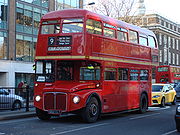
Routemaster
The AEC Routemaster is a model of double-decker bus that was built by Associated Equipment Company in 1954 and produced until 1968. Primarily front-engined, rear open-platform buses, a small number of variants were produced with doors and/or front entrances...
has now been withdrawn from all regular service routes, they are still in use on two heritage routes in central London. The heritage routes are operated as part of the standard London Buses network, and issue and accept the same fares as the rest of that network. The two routes are heritage route 9
London Buses route 9 (Heritage)
London Buses route 9 is a Transport for London contracted bus route in London, England, United Kingdom. The service is currently contracted to First Centrewest.It is a short working of the standard route 9...
from Kensington High Street
Kensington High Street
Kensington High Street is the main shopping street in Kensington, west London. The area is identified in the London Plan as one of 35 major centres in Greater London....
to Aldwych
Aldwych
Aldwych is a place and road in the City of Westminster in London, England.-Description:Aldwych, the road, is a crescent, connected to the Strand at both ends. At its centre, it meets the Kingsway...
, and heritage route 15
London Buses route 15 (Heritage)
London Buses route 15 is a Transport for London contracted bus route in London, England, United Kingdom. The service is currently contracted to Stagecoach London and is a short working of the standard route 15.-History:...
from Trafalgar Square
Trafalgar Square
Trafalgar Square is a public space and tourist attraction in central London, England, United Kingdom. At its centre is Nelson's Column, which is guarded by four lion statues at its base. There are a number of statues and sculptures in the square, with one plinth displaying changing pieces of...
to Tower Hill
Tower Hill
Tower Hill is an elevated spot northwest of the Tower of London, just outside the limits of the City of London, in the London Borough of Tower Hamlets. Formerly it was part of the Tower Liberty under the direct administrative control of Tower...
.
Routemaster buses are not accessible to passengers in wheelchair
Wheelchair
A wheelchair is a chair with wheels, designed to be a replacement for walking. The device comes in variations where it is propelled by motors or by the seated occupant turning the rear wheels by hand. Often there are handles behind the seat for someone else to do the pushing...
s and other mobility impaired passengers. Because of this, each heritage route is operated as a short-working of a regular service route bearing the same route number, thus ensuring that passengers unable to board the heritage buses are offered equivalent alternative transport arrangements.
Tour buses
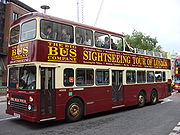
Tour bus
A tour bus service is a bus service that takes visitors sightseeing, with routes around tourist attractions. Double-decker buses and/or open top buses are commonly used, for their good views....
es, the majority being open-top buses. These are double-decker buses with a fully or partially open upper deck, which provide tourist services with either live or recorded commentary. Most of these services allow passengers to embark and disembark at any of the company's stops
Bus stop
A bus stop is a designated place where buses stop for passengers to board or leave a bus. These are normally positioned on the highway and are distinct from off-highway facilities such as bus stations. The construction of bus stops tends to reflect the level of usage...
, continuing their journey on a later bus.
There are several competing operators of such services which do not form part of the London Buses network and do not issue or accept London Buses tickets, although at least one paints its buses in the same red as London's local buses. Fares are set by the operators, usually a flat fee for a day's (or multiple days') usage; there is no need to pre-book and tickets can be bought from the driver or bus-stop ticket sellers.
Other more formally organised tours use luxury coaches and generally need to be booked in advance through travel agents.
Long distance coaches
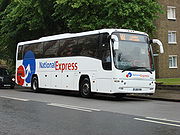
United Kingdom
The United Kingdom of Great Britain and Northern IrelandIn the United Kingdom and Dependencies, other languages have been officially recognised as legitimate autochthonous languages under the European Charter for Regional or Minority Languages...
and with other cities in Europe
Europe
Europe is, by convention, one of the world's seven continents. Comprising the westernmost peninsula of Eurasia, Europe is generally 'divided' from Asia to its east by the watershed divides of the Ural and Caucasus Mountains, the Ural River, the Caspian and Black Seas, and the waterways connecting...
. Most of these services are run by National Express
National Express
National Express Coaches, more commonly known as National Express, is a brand and company, owned by the National Express Group, under which the majority of long distance bus and coach services in Great Britain are operated,...
and their European affiliate Eurolines
Eurolines
Eurolines is a coach organisation, operating international bus routes within Europe and Morocco to over 500 destinations in over 25 countries. Rather than being a single company, Eurolines is a network of co-operating bus companies from all over Europe, offering integrated ticketing and extensive...
. National Express's predominantly white vehicles are common on the roads of central London, on their way to and from their terminus at Victoria Coach Station
Victoria Coach Station
Victoria Coach Station is the largest and most significant coach station in London. It serves long distance coach services and is also the departure point for many countryside coach tours originating from London. It should not be confused with the nearby Green Line Coach Station serving Green Line...
.
Recently competition for long distance traffic has been introduced by Megabus
Megabus (United Kingdom)
Megabus is a UK coach service operated by Stagecoach Group. It started in 2003 and as of February 2010 operated 19 UK coach routes serving 41 destinations in England, Scotland and Wales. Some services link with Megatrain services which are also operated by Stagecoach...
, a subsidiary of the large UK bus operating company Stagecoach
Stagecoach Group
Stagecoach Group plc is an international transport group operating buses, trains, trams, express coaches and ferries. The group was founded in 1980 by the current chairman, Sir Brian Souter, his sister, Ann Gloag, and her former husband Robin...
. This company operates cheap services aimed at student
Student
A student is a learner, or someone who attends an educational institution. In some nations, the English term is reserved for those who attend university, while a schoolchild under the age of eighteen is called a pupil in English...
s and the like, which must be booked in advance on the Internet
World Wide Web
The World Wide Web is a system of interlinked hypertext documents accessed via the Internet...
.
Other coach services link London to medium-distance destinations, and unlike National Express or Megabus provide walk-on fares. Good examples of this are the Green Line
Green Line Coaches
Green Line is a commuter coach brand in the Home Counties of England. It is owned by the Arriva group.Green Line has its origin in the network of coach services established by the London General Omnibus Company in the 1920s and 1930s...
services to the Home Counties, mainly operated by Arriva
Arriva
Arriva plc is a multinational public transport company owned by Deutsche Bahn and headquartered in Sunderland, United Kingdom. It has bus, coach, train, tram and waterbus operations in 12 countries across Europe, employs more than 47,500 people and services over 1.5 billion passenger journeys each...
, the service to the city of Oxford
Oxford to London coach route
The Oxford to London coach route is an express coach route between Oxford and London along the M40 motorway. The Oxford Tube, which is operated by Stagecoach runs 5 coaches an hour via Lewknor, Hillingdon in west London, Shepherd's Bush and terminates in Buckingham Palace Road, Victoria...
, where Stagecoach's
Stagecoach Group
Stagecoach Group plc is an international transport group operating buses, trains, trams, express coaches and ferries. The group was founded in 1980 by the current chairman, Sir Brian Souter, his sister, Ann Gloag, and her former husband Robin...
frequent Oxford Tube
Stagecoach South Midlands
Stagecoach in Oxfordshire is the name given to Stagecoach Group bus operations in the county of Oxfordshire, England. It used to be part of Stagecoach South Midlands along with Stagecoach in Warwickshire until March 2004.-History:...
service competes with Go-Ahead's
Go-Ahead Group
The Go-Ahead Group plc is a rail and bus operating company that was created following the privatisation of the UK's train and bus industries. It is listed on the London Stock Exchange and is a constituent of the FTSE 250 Index.-Early history:...
similar Oxford Express
Oxford Bus Company
Oxford Bus Company is a bus operator serving the city and surrounding area of Oxford, England and is the trading name of City of Oxford Motor Services Ltd. It is now a subsidiary of the Go-Ahead Group...
service, and the many commuter services to medium-distance destinations operated by individual coach companies during peak times.
Airport buses
National ExpressNational Express
National Express Coaches, more commonly known as National Express, is a brand and company, owned by the National Express Group, under which the majority of long distance bus and coach services in Great Britain are operated,...
is also the principal airport bus operator, serving Heathrow
London Heathrow Airport
London Heathrow Airport or Heathrow , in the London Borough of Hillingdon, is the busiest airport in the United Kingdom and the third busiest airport in the world in terms of total passenger traffic, handling more international passengers than any other airport around the globe...
, Gatwick
London Gatwick Airport
Gatwick Airport is located 3.1 miles north of the centre of Crawley, West Sussex, and south of Central London. Previously known as London Gatwick,In 2010, the name changed from London Gatwick Airport to Gatwick Airport...
and Stansted
London Stansted Airport
-Cargo:-Statistics:-Infrastructure:-Terminal and satellite buildings:Stansted is the newest passenger airport of all the main London airports. The terminal is an oblong glass building, and is separated in to three areas: Check-in concourse, arrivals and departures...
with its National Express Airport brand. Unlike their longer distance cousins, these are walk-on services, which serve stops throughout central London rather than running to Victoria Coach Station
Victoria Coach Station
Victoria Coach Station is the largest and most significant coach station in London. It serves long distance coach services and is also the departure point for many countryside coach tours originating from London. It should not be confused with the nearby Green Line Coach Station serving Green Line...
.
London City Airport
London City Airport
London City Airport is a single-runway airport. It principally serves the financial district of London and is located on a former Docklands site, east of the City of London, opposite the London Regatta Centre, in the London Borough of Newham in east London. It was developed by the engineering...
used to provide express shuttle bus services to connect the airport to rail and underground stations at Canning Town
Canning Town station
Canning Town station is an inter-modal transport interchange in Canning Town, northeast London, England. It is served by the London Underground Jubilee line, the Docklands Light Railway and local buses operated for London Buses. It is in Travelcard Zone 3...
, Canary Wharf
Canary Wharf
Canary Wharf is a major business district located in London, United Kingdom. It is one of London's two main financial centres, alongside the traditional City of London, and contains many of the UK's tallest buildings, including the second-tallest , One Canada Square...
and Liverpool Street
Liverpool Street station
Liverpool Street railway station, also known as London Liverpool Street or simply Liverpool Street, is both a central London railway terminus and a connected London Underground station in the north-eastern corner of the City of London, England...
. These operated at a premium fare (compared with the parallel but slower London Buses
London Buses
London Buses is the subsidiary of Transport for London that manages bus services within Greater London, UK. Buses are required to carry similar red colour schemes and conform to the same fare scheme...
services) but did not survive the extension of the Docklands Light Railway
Docklands Light Railway
The Docklands Light Railway is an automated light metro or light rail system opened on 31 August 1987 to serve the redeveloped Docklands area of London...
to the airport in late 2005.
Terrorist incidents
- 18 February 1996: An improvised explosive deviceImprovised explosive deviceAn improvised explosive device , also known as a roadside bomb, is a homemade bomb constructed and deployed in ways other than in conventional military action...
detonated prematurely on a bus travelling along AldwychAldwychAldwych is a place and road in the City of Westminster in London, England.-Description:Aldwych, the road, is a crescent, connected to the Strand at both ends. At its centre, it meets the Kingsway...
in central LondonCentral LondonCentral London is the innermost part of London, England. There is no official or commonly accepted definition of its area, but its characteristics are understood to include a high density built environment, high land values, an elevated daytime population and a concentration of regionally,...
, killing Edward O'Brien, the IRAProvisional Irish Republican ArmyThe Provisional Irish Republican Army is an Irish republican paramilitary organisation whose aim was to remove Northern Ireland from the United Kingdom and bring about a socialist republic within a united Ireland by force of arms and political persuasion...
terrorist transporting the device, and injuring eight others. - 7 July 2005: An explosion occurred as part of a coordinated attack on London7 July 2005 London bombingsThe 7 July 2005 London bombings were a series of co-ordinated suicide attacks in the United Kingdom, targeting civilians using London's public transport system during the morning rush hour....
at 09:47 on a No. 30London Buses route 30London Buses route 30 is a Transport for London contracted bus route in London, United Kingdom. The service is currently contracted to First Capital.-History:Route 30 commenced operation on 8 May 1911 between Kings Cross and Fulham Cross...
Hackney WickHackney WickHackney Wick is an area straddling the boundary between the London Borough of Hackney and the London Borough of Tower Hamlets in east London. It is an inner-city development situated 5 miles northeast of Charing Cross...
to Marble ArchMarble ArchMarble Arch is a white Carrara marble monument that now stands on a large traffic island at the junction of Oxford Street, Park Lane, and Edgware Road, almost directly opposite Speakers' Corner in Hyde Park in London, England...
double-decker busDouble-decker busA double-decker bus is a bus that has two storeys or 'decks'. Global usage of this type of bus is more common in outer touring than in its intra-urban transportion role. Double-decker buses are also commonly found in certain parts of Europe, Asia, and former British colonies and protectorates...
, operated by Stagecoach GroupStagecoach GroupStagecoach Group plc is an international transport group operating buses, trains, trams, express coaches and ferries. The group was founded in 1980 by the current chairman, Sir Brian Souter, his sister, Ann Gloag, and her former husband Robin...
for Transport for LondonTransport for LondonTransport for London is the local government body responsible for most aspects of the transport system in Greater London in England. Its role is to implement the transport strategy and to manage transport services across London...
, in Tavistock SquareTavistock SquareTavistock Square is a public square in Bloomsbury, in the London Borough of Camden with a fine garden.-Public art:The centre-piece of the gardens is a statue of Mahatma Gandhi, which was installed in 1968....
. The bomb ripped the roof off the top deck and destroyed the back of the bus, killing thirteen passengers and the suicide bomber. - 21 July 2005: A suicide bomber attempted to explode a bomb as part of a second coordinated attack on London21 July 2005 London bombingsOn 21 July 2005, four attempted bomb attacks disrupted part of London's public transport system two weeks after the 7 July 2005 London bombings. The explosions occurred around midday at Shepherd's Bush, Warren Street and Oval stations on London Underground, and on a bus in Shoreditch...
at 13:30 on a No. 26London Buses route 26London Buses route 26 is a Transport for London contracted bus route in London, United Kingdom. The service is currently contracted to First Capital.-History:...
WaterlooWaterloo stationWaterloo station, also known as London Waterloo, is a central London railway terminus and London Underground complex. The station is owned and operated by Network Rail and is close to the South Bank of the River Thames, and in Travelcard Zone 1....
to Hackney WickHackney WickHackney Wick is an area straddling the boundary between the London Borough of Hackney and the London Borough of Tower Hamlets in east London. It is an inner-city development situated 5 miles northeast of Charing Cross...
double-decker busDouble-decker busA double-decker bus is a bus that has two storeys or 'decks'. Global usage of this type of bus is more common in outer touring than in its intra-urban transportion role. Double-decker buses are also commonly found in certain parts of Europe, Asia, and former British colonies and protectorates...
, operated by Stagecoach GroupStagecoach GroupStagecoach Group plc is an international transport group operating buses, trains, trams, express coaches and ferries. The group was founded in 1980 by the current chairman, Sir Brian Souter, his sister, Ann Gloag, and her former husband Robin...
for Transport for LondonTransport for LondonTransport for London is the local government body responsible for most aspects of the transport system in Greater London in England. Its role is to implement the transport strategy and to manage transport services across London...
, on Hackney Road at the corner of Columbia Road in ShoreditchShoreditchShoreditch is an area of London within the London Borough of Hackney in England. It is a built-up part of the inner city immediately to the north of the City of London, located east-northeast of Charing Cross.-Etymology:...
. The device failed to detonate properly and there were no injuries.
See also
- Transport for LondonTransport for LondonTransport for London is the local government body responsible for most aspects of the transport system in Greater London in England. Its role is to implement the transport strategy and to manage transport services across London...
- London BusesLondon BusesLondon Buses is the subsidiary of Transport for London that manages bus services within Greater London, UK. Buses are required to carry similar red colour schemes and conform to the same fare scheme...
- London UndergroundLondon UndergroundThe London Underground is a rapid transit system serving a large part of Greater London and some parts of Buckinghamshire, Hertfordshire and Essex in England...
- List of bus routes in London
- List of bus types used in London
- The Big Bus CompanyThe Big Bus CompanyBig Bus Tours is a London-based open-top bus sightseeing company.The Big Bus Company is a family-owned company, founded by Richard, Eleanor and Desmond Maybury. It started in central London in June 1991 with 4 buses and now operates over 150 buses worldwide...

